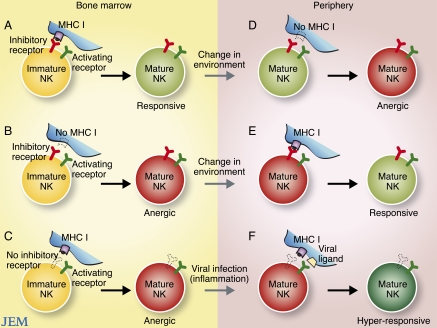Figure 1.
Education and re-education of NK cells. The figure depicts the “education” of developing NK cells in different bone marrow environments (left) and the experimental “re-education” of mature NK cells in different peripheral environments (right). (A) Immature NK cells expressing inhibitory receptors that engage MHC class I become responsive mature effector cells. (B) Immature NK cells expressing inhibitory receptors that do not engage MHC class I become anergic cells. (C) Immature NK cells lacking inhibitory receptors that can engage MHC class I also become anergic cells. (D) Mature responsive NK cells that are adoptively transferred into a MHC class I–deficient environment become anergic. (E) Mature anergic NK cells (expressing inhibitory receptors for MHC class I) that are adoptively transferred into a MHC class I–sufficient setting become responsive. (F) During viral infection and inflammation, mature anergic NK cells (lacking inhibitory receptors for MHC class I) become activated and hyperresponsive effector cells.

